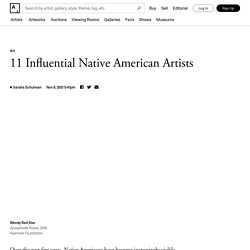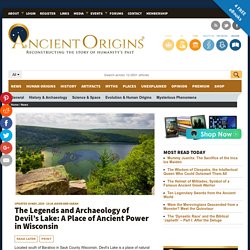

11 Influential Native American Artists. From the mean streets of Manhattan to the mountain vistas of Mesa, Arizona, multimedia artist Brad Kahlhamer lives in two different worlds, making spiritual, cosmic, punk aesthetic–infused art.

Through this alchemy, and by drawing on his own personal history and biography, Kahlhamer creates what he calls the “third place.” Born in Tucson, Arizona, to Apache parents, Kahlhamer was adopted by a German family and raised in the nearby city of Mesa and, later, the state of Wisconsin. In 1982, Kahlhamer moved to New York and spent a decade as a touring musician, and 10 more years as a graphic designer for Topps Chewing Gum Company. Alloprof aide aux devoirs. 10 Native American Inventions - HISTORY.
From the tip of South America to the Arctic, Native Americans developed scores of innovations—from kayaks, protective goggles and baby bottles to birth control, genetically modified food crops and analgesic medications—that enabled them to survive and flourish wherever they lived.

In fact, early European explorers who reached the Western Hemisphere were apparently so impressed by the achievements of the people they encountered that they felt compelled to dream up stories about Native Americans being descendants of ancient Phoenician traders or a lost tribe of Israel, in an effort to explain the source of their technological prowess. “People don’t realize the ingenuity or the knowledge that native people had, and continue to have about the world around them,” explains Gaetana De Gennaro, a supervisory specialist at the National Museum of the American Indian in New York, who manages a permanent interactive exhibit on Native American inventions. Corn Rubber. El texto en latín precolombino menciona la existencia de las Américas.
Mother, matriarchy and strength: Multi-artist exhibition highlights resiliency of Indigenous women. Reviews and recommendations are unbiased and products are independently selected.

Postmedia may earn an affiliate commission from purchases made through links on this page. Article content It was July of 2020 when Autumn Whiteway decided on a specific theme for a group exhibition featuring Indigenous artists. La culture autochtone contemporaine plus que vibrante. Un voyage au Canada est une occasion unique d’aller à la rencontre des Premières Nations, habitants millénaires avec une richesse et une diversité culturelle incroyable.

Peut-être visiterez-vous un site comme le site Huron Wendat, assisterez à un Pow-Wow ou encore vivrez une expérience en immersion comme Amishk Aventures. Autant d’expériences enrichissantes qui vous plongeront dans la culture traditionnelle et vous laisseront une empreinte mémorable. Astonishing Earthen Structures Showcase Early Native Americans' Engineering Skills.
Poverty Point in northern Louisiana is one of the first US civilizations on record, inhabited by a community of Native Americans as early as 1700 BCE.

In a new study, researchers have shown these inhabitants to be highly skilled engineers, rather than the simpler hunter-gatherers they're often portrayed as. The massive earthen structures put up at Poverty Point – in just a few months or weeks – are evidence that the people who lived here thousands of years ago very much knew what they were doing in terms of engineering and building, the researchers say. Even today the center of the Poverty Point World Heritage Site is dominated by a mound that rises more than 20 meters (66 feet) above the ground, and millions of cubic meters of soil would have had to be shifted and piled in order to create these mounds – they are not straightforward building projects.
The Poverty Point site. Chien d'Indiens Natifs Americains : caractéristiques, prix, alimentation et santé de cette race de chien. Chiens amérindiens, chiens français : histoire d'une rencontre*. Premiers chiens d'Amérique du Nord : Carnets d'histoire naturelle. Le chien domestique (Canis familiaris) descend du loup (Canis lupus), et les deux vivent en association avec les êtres humains depuis des milliers d’années.

Les preuves génétiques laissent croire que les autochtones et les Européens ont domestiqué les chiens indépendamment les uns des autres, et que les chiens d’Amérique du Nord d’avant le contact européen ont été presque entièrement remplacés par ceux qui ont traversé l’océan sur des bateaux européens. Avant l’arrivée des Européens en Amérique du Nord, les chiens avaient de nombreuses utilités : on les utilisait comme animaux de trait dans les plaines ainsi que dans le haut Arctique on en faisait l’élevage pour la laine comme les moutons et leur poil servait à faire des couvertures il y avait des chiens sans poil qu’on utilisait comme bouillottes vivantes pour soulager les articulations douloureuses on les mangeait ils avaient une importance pour la religion on les enterrait dans des cimetières comme les personnes.
Yes world, there were horses in Native culture before the settlers came - Indian Country Today. Yvette Running Horse Collin’s recent dissertation may have rewritten every natural history book on the shelf.

A Lakota/Nakota/Cheyenne scholar, Collin worked within the University of Alaska Fairbanks’ Indigenous Studies program to synthesize fossil evidence, historical documents and oral history to present a compelling new story of the horse in the Americas. The horse was here well before the settlers. “We have calmly known we've always had the horse, way before the settlers came.
National Museum of the American Indian. Bonjour Samba - Une discographie idéale de musique brésilienne. “Si vous avez quinze tomes pour parler de la musique brésilienne, c’est certain que c’est peu.

Mais si vous disposez à peine de l’espace d’un mot alors, alors tout n’est pas perdu: Écrivez vite: Pixinguinha“. Bonjour Samba - Une discographie idéale de musique brésilienne. Si on cherchait à s’accorder sur le musicien qui incarne le mieux le Sud du Brésil, le débat ferait rage.

L'Empire comanche. The Legends and Archaeology of Devil’s Lake: A Place of Ancient Power in Wisconsin. Located south of Baraboo in Sauk County Wisconsin, Devil’s Lake is a place of natural wonder and legend.

The central feature of the biggest State Park in Wisconsin, Devil’s Lake covers 360 acres (146 hectares), surrounded by quartzite bluffs reaching 500 feet (152 meters) in height. In 1832, a French agent of the American Fur Company named John de La Ronde visited the lake and noted that it was the echo effect of the bluffs and the “darkness of the place” which inspired the French Voyageurs to use the name Devil’s Lake. La Ronde also mentioned an older, indigenous tradition: “The Indians gave it the name of Holy Water, declaring that there is a spirit or Manitou that resides there.
Aquí puedes ver más de 200 películas y animaciones indígenas totalmente gratis. Los indígenas son habitantes del mundo quienes se han mantenido relativamente alejados de los procesos de modernización desde hace siglos. Esto les permite mantener sus invaluables tradiciones, símbolos y culturas que les dan identidad. Pero, aunque las sociedades indígenas tienen su propio tiempo y espacio, su propio ritmo, esto no las imposibilita para hacerse de nuevos conocimientos y prácticas. The Dakota Sioux Execution Was The Largest In U.S. History — But America Has Forgotten It.
Supreme Court Might Return Half Of Oklahoma To Cherokee. California Condors Could Soon Soar Above the Redwoods Again Thanks to One Local Tribe. L'esprit des hommes de la Terre de Feu. Martin Gusinde est l’un des rares occidentaux à avoir vécu parmi les peuples Selk’nam, Yamana et Kawésqar. Le photographe et missionnaire allemand effectue quatre voyages en Terre de Feu entre 1918 et 1924.
Il s'immerge en profondeur au sein de ces sociétés jusqu'à parler la langue et être introduit aux rites initiatiques. Les 1200 clichés qu’il rapporte, réalisés à la chambre photographique portable, constituent un témoignage unique sur ces peuples aujourd’hui disparus. Indigenous Women as Leaders will Turn the World “Right Side Up.” The first woman to serve as Cherokee Nation’s Principal Chief, the late Wilma Mankiller, once said “Women can help turn the world right side up.”
With frequent mass shootings, rising White nationalism, record breaking natural disasters, and a growing political divide, the world has never felt more upside down. Indian Country has even more cause for alarm. In the past two years, Native leaders have watched the United States government diminish the Bears Ears National Monument, greenlight the controversial Dakota Access pipeline, uphold restrictive voter ID laws in North Dakota, and take tribal land out of trust for the first time since President Truman.
In these urgent political times, Native women are not sitting by, but running for office in record-breaking numbers. In local, state and national elections, over fifty Native women are running in 2018. Using old photography methods to tell new Native American stories. The portraits' revealing details—a baseball cap, tank top, wristwatch, down vest—contradict their old and withered appearance. What at first seem to be historic photographs are actually contemporary tintypes, images from respective projects about Native Americans from artists Will Wilson and Kali Spitzer.
Although their work employs an archaic medium, Wilson and Spitzer’s photographs have much to say about present-day Native American life. Sacred Ojibwa scrolls found after 70 years - Canada. In the 1930s, an American anthropologist named Irving Hallowell journeyed north to Canada to live among the Ojibwa and study their culture. He left with a wealth of knowledge - and something else. He took a bundle of sacred scrolls, made out of birch bark, and central to the performance of ancient religious ceremonies of the tribe.
The scrolls were never forgotten by those whose ancestors used them. Some elders in the tribe remember the old ways of doing things. Elder Donald Bird still uses the sweat lodge behind his house. The Marked Woman. In the early twentieth century, the members of the Osage Nation became the richest people per capita in the world, after oil was discovered under their reservation, in Oklahoma. Then they began to be mysteriously murdered off. In 1923, after the death toll reached more than two dozen, the case was taken up by the Bureau of Investigation, then an obscure branch of the Justice Department, which was later renamed the Federal Bureau of Investigation.
The case was among the F.B.I.’s first major homicide investigations. After J. Edgar Hoover was appointed the bureau’s director, in 1924, he sent a team of undercover operatives, including a Native American agent, to the Osage reservation. David Grann, a staff writer at the magazine, has spent nearly half a decade researching this submerged and sinister history. In April, millions of tiny flowers spread over the blackjack hills and vast prairies in the Osage territory of Oklahoma.
The True Story of Pocahontas: Historical Myths Versus Sad Reality - Indian Country Media Network. Despite what many people believe due to longstanding and inaccurate accounts in history books and movies such as Disney’s Pocahontas, the true story of Pocahontas is not one of a young Native Powhatan woman with a raccoon friend who dove off of mountain-like cliffs off the coasts of Virginia. (Note: there are no cliffs on the coast of Virginia.)
The true story of Pocahontas is a tale of tragedy and heartbreak. Disney / Everett Collection Disney’s Pocahontas -Buena Vista/courtesy Everett Collection It is time to bust up the misconceptions perpetuated over 400 years regarding the young daughter of Powhatan chief Wahunsenaca. O Pioneer! The Ceramic Art of Jody Folwell. Body { } h1 { } h2 { } h3 { } h4 { } h5 { } h6 { } Hard Rock TULSA. 36 portraits saisissants de jeunes filles amérindiennes de la fin des années 1800 au début des. Tous ces portraits amérindiens incroyablement rares et magnifiques sont des femmes et des filles de la fin des années 1800 au début des années 1900. Les images ont été bien conservées et cela nous permet d’admirer ces femmes, leur style unique, et de montrer du respect pour leur vie. Même si les femmes amérindiennes avaient souvent différents rôles que les hommes, elles étaient très respectées.
Elles avaient souvent les mêmes sortes de droits sur les hommes dans leur tribu ce qui est incroyable pour cette époque. Dans certains groupes, c’était les femmes qui possédaient la maison et les biens à l’intérieur. Alors qu’il était typique que le chef soit un homme, dans certaines tribus il était choisi par les femmes. Pain of 'Trail of Tears' shared by Blacks as well as Native Americans. Editor's Note: Tiya Miles is chairwoman of the Department of Afro-American and African Studies, and professor of history and Native American studies at the University of Michigan. She is the author of "Ties That Bind: The Story of an Afro-Cherokee Family in Slavery and Freedom" and "The House on Diamond Hill: A Cherokee Plantation Story. " She is also the winner of a 2011 "genius grant" from the MacArthur Foundation.
The Real History of Black Native Americans. Throughout the years many black people have laid claim to Native American heritage, claiming it is responsible for everything from reddish skin tone to straight, long hair. Scholar Henry Louis Gates recently discovered that this is likely not true. The percentage of Native American blood in the typical African American is actually very small — less than 1%. So how did Native Americans and Africans begin to blend together? Although there are over 500 federally recognized Native American tribes, only 5 were considered to be “civil” during the colonial period.
These 5 tribes which consisted of Cheek, Chocktaw, Cherokee, Chickasaw and Seminole had adopted colonial practices such as Christianity, written constitutions and plantation slavery. Fort Toulouse - Fort Jackson. Fort Toulouse (Circa 1756) by Davy Hobbs Ayokpache Eno Mokla (Hello my friend) Welcome to this great pastime! The Indians of the Southeastern United States. by John R. Swanton. The Indians of the Southeastern United States. By John R. Swanton. (Bulletin 137, Smithsonian Institution, Bureau of American Ethnology, United States Government Printing Office, Washington, B.C., 1946, pp. xiii, 943. Maps, plates, tables, sketches, bibliography, and index. $2.75.)
John Reed Swanton (Swanton, John Reed, 1873-1958) The Last of the Sioux Video - Native American Cultures. National Register of Historic Places Indian Mounds of Mississippi Travel Itinerary. Prehistoric America plus the Ainu and Jomon. Black U.S. Indians. Interactives . United States History Map . Indians. Mysterious Stone Chambers & Giants Discovered in New England- Jim Vieira. How the west was lost~Dakota~Let them eat grass. Mississippian Culture-Blue Licks Battlefield reenactment. Choris Stock Photos & Choris Stock Images - Alamy.
Native American - Civilizing the Native American - Immigration...- Classroom Presentation. Native American - Civilizing the Native American - Immigration...- Classroom Presentation. Crow Nation. Indien, Amérique Du Nord et ailes de poulet à la mode Buffalo. Study Abroad with SEA Semester: Ocean Science & Sailing Program - Nautical, Environmental & Oceanography Studies. Native American Tribe Cheyenne sur Pinterest Anthony luke's not-just-another-photoblog Blog: Fascinating 19th Century Portraits of Native American Indians ~ By Photographer Frank A. Rinehart. McKenney and Hall Indian Tribes of North America. Old Photos - Ojibwa (aka Ojibwe, aka Ojibway) Cahokia’s emergence and decline coincided with shifts of flood frequency on the Mississippi River. Ancient Cahokia. Cahokian Indians: America's Ancient Warriors. Native Americans:Prehistoric:Mississippian. Mississippian Period: Overview.
Centennial (U.S. National Park Service) Harvard Museums of Science & Culture. Of Archaeology and Ethnology at Harvard University. NATIVE PEOPLES of NORTH AMERICA - Mississippian Traditions. WQXR - New York's Classical Music Radio Station. View of Newport's Agate Beach, from Above: Oregon Coast, Newport Virtual Tour. *Amérique. Moses On The Mesa – “MOSES ON THE MESA” SCREENINGS.
Hermès Noir ou le « dieu qui ouvre les barrières » ? - à la cantine. Ségolène Lavaud Michal - Jacques Roumain et Jacques-Stephen Alexis ; réalisme merveilleux et artistes peintres (II) - Île en île. Etats-Unis. Festival de Chaillol. Catalogue Original 1963. It’s yoga bear: Supple Santra has more keep-fit moves than the average bear - knutisweekly.com. Surf-Inspired Apparel, Tees, Hats and Accessories for Men, Women and Kids.
Abandoned House in the Woods Taken Over by Wild Animals.